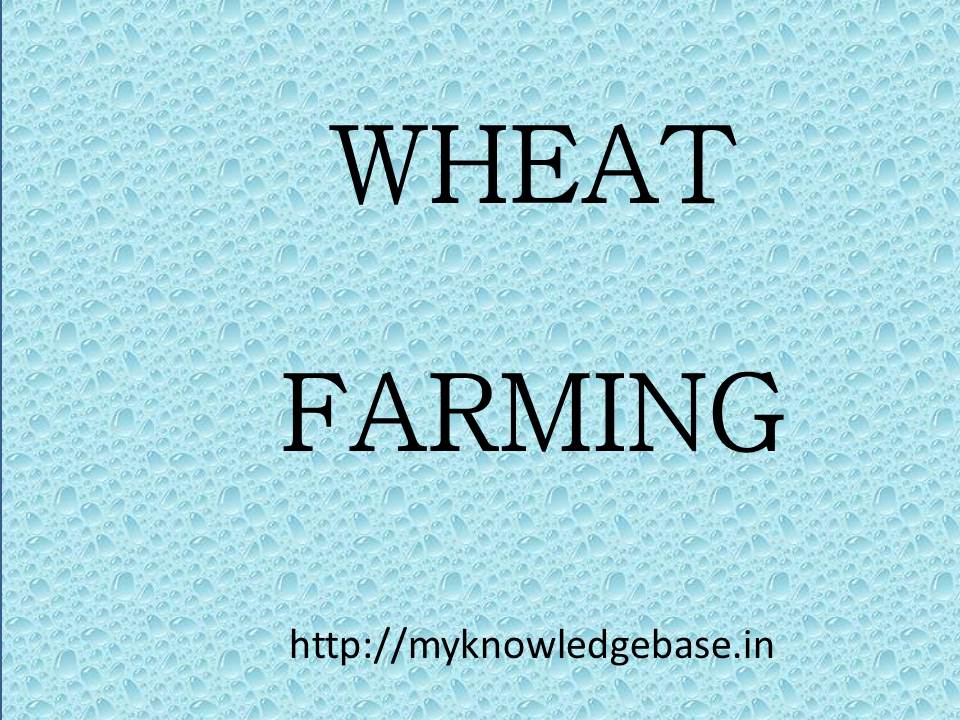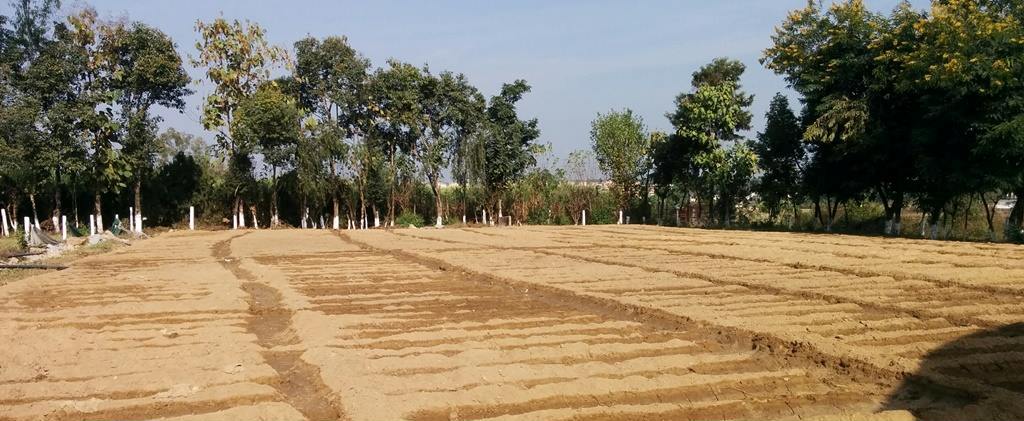Interested in WHEAT Farming ?
Some Introduction to WHEAT
Wheat is a staple cereal for a large population worldwide. It is difficult to believe of human sustenance without wheat. Wikipedia records that Wheat is grown on more land area than any other food crop. World trade in wheat is greater than for all other crops combined. In 2016, world production of wheat was 749 million tonnes, making it the second most-produced cereal after maize. Wheat is an important source of carbohydrates, protein, nutrients and fiber.
The seeds of wheat grass are cereal grains, and are staple food for millions of human beings. Botanically,wheat kernel is a type of fruit called ‘caryopsis’ – a type of simple dryfruit. Other such caryopsis is maize and rice.
Wheat is believed to have been cultivated in the regions of the Fertile Crescent around 9600 Before Common Era (BCE). By 6500 BCE it seems to have reached Greece, Cyprus and India. By 3000 BCE it reached British Isles and a millennium later China.(source: Wikipedia)
Classification of WHEAT
Wheat is named differently in different places. Whatever the names, classification methods for wheat varieties follow same standards:
Growing season – winter grown or summer grown.
Protein content. High, Medium or Low.
The quality of the wheat protein gluten. This protein can determine the suitability of wheat for a particular use.
Grain color – red,white or amber. Phenolic compounds present in the bran layer impart color to wheat grains.
Nutrition provided by WHEAT
Wheat provides carbohydrates, proteins, nutrients and fiber. Generally as an average, 100 grams wheat provides about 320 kilo calories.It also provides multiple essential nutrients such as protein, vitamins, fiber, minerals. Wheat has about 13% water, 70% carbohydrates and negligible fat. Its 13% protein content is mostly gluten.
Commercial Use
Worldwide wheat is cultivated as cash crop and wheat farmers benefits from such cultivation. Wheat can be easily stored. Use of wheat flour in different ways is done, the best example being bread which is almost universally eaten across the world. Stored wheat is a highly concentrated form of food
Different countries Different Yields
According to Wikipedia, the average annual world farm yield for wheat in 2014 was 3.3 tonnes per hectare (330 grams per square meter). Among the top most productive farmers were: 1.Ireland with a nationwide average of 10.0 tonnes per hectare, 2. Netherlands(9.2), and 3. Germany, New Zealand and the United Kingdom (each with 8.6).https://en.wikipedia.org/wiki/Wheat#cite_note-fao-prod2014-7
Top WHEAT producers in 2014
| Country | millions of tonnes |
| European Union | 157.3 |
| China | 126.2 |
| India | 95.8 |
| Russia | 59.7 |
| United States | 55.1 |
| France | 39.0 |
| Canada | 29.3 |
| Germany | 27.8 |
| Pakistan | 26.0 |
| Australia | 25.3 |
| Ukraine | 24.1 |
| World | 720 |
| Source: UN Food & Agriculture Organization[7] |
Suitable climate for WHEAT growing
It is grown under a wide range of climatic conditions. However, it can not stand too hot or too cold weather. It prefers moderate temperature in summer as well as in winter. Short days are not favorable for the formation of bulbs. Winter wheat lies dormant during winter and grows rapidly in spring. Too cold conditions damage the crop. Spring wheat is sown just as spring starts and harvested in summer. Winter wheat makes for fine flour.
Land Preparation
Wheat grows in many types of soil, but it grows best in well-drained loam or clay-loam soils. Two major threats to the wheat plant’s growth are poor soil drainage and high levels of soil acidity. The wheat roots penetrate earth at shallow depths maybe around 6-7 cm. Land needs to be well pulverized. For this land maybe first irrigated and then ploughed two or three times. The seed and initial fertilizers (and if required pesticides and fungicides, depending on the soil) are then planted together. Thereafter one ploughing and one leveling is done so that there is no water drainage problems. This also eliminates any other type of vegetation in the field.
Sowing Methods
- Broadcasting: In this method the seeds are broadcast and then worked in by harrowing in order to cover them.
- Behind Local Plough: A majority of farmers uses this method. This method consists of dropping the seeds by hand into the furrows that have been opened with local plough.
- Drilling: In this method seed is sown by specially made drills called seed drill or ferti-seed drill. With the help of this implement seed drop at desired depth and results in uniform germination and regular stand.
- Dibbling: This method is used in case where supply of seed is limited. Sowing is done with the help of a small implement known as ‘Dibbler’. It is a wooden or iron frame with pegs. The frame is pressed in the field and lifted and then one or two seeds are dropped by hand in each of the hole. It is not a common method because it is a very time consuming process.
- Zero tillage technique: This new method is used in Rice-Wheat cropping system so that rice stubble need not be removed or destroyed but is utilized as a fertilizer itself. Specially made machines are used for this method.
Depth of sowing
Deep sowing may delay or stifle emergence, while shallow sowing risks seed damage from herbicide uptake. The length of the first shoot (coleoptile) has a bearing on depth of sowing. If a variety is sown deeper than the natural growth extension of the coleoptile, then seedling may not emerge. Most current varieties are derived from so called semi-dwarf lines which have shorter stems and shorter coleoptiles than older varieties.
Depth of sowing depends on soil type and availability of moisture influence. Sowing depths indicated are between 25mm and 50mm depending on soil type and available moisture. Moist conditions shallower depth placements may encourage faster emergence and crop establishment.
Quantity of seed
Farmers aim to achieve a crop density of 150-200 plants per square meter. This means around 60kg/ha seeding rate in lower rainfall zones (up to 400mm annual rainfall) and around 80-90kg/ha in the higher rainfall zones.
Manures and Fertilizers
Fertilizer application actually depends upon the soil of the farmer. It is recommended to have the soil and water analyzed before deciding on the actual quantity of fertilizers. As a normal practice the following fertilizers are indicated for wheat farming.
Nitrogen, phosphorus, potassium, sulfur, zinc, copper,boron, manganese, iron, and magnesium are required by wheat and most of them are available in soil. Nitrogen is required in the largest amount because it is part of all the proteins in the plant. High yields require higher nitrogen. Wheat also needs a lot of phosphorus, most of which ends up in the grain. Farmer may give 3kg/ha of phosphorus per tonne of expected yield. Other nutrients from the soil are needed in smaller amounts, but all must be present for healthy plant growth and color.
Farm Yard Manure is highly desirable in the land, whatever be the crop. It is same with wheat also. Mixing of around 2 to 2.5 tonnes of FYM per hectares is sufficient. Apart from FYM, it is also recommended to give following fertilizers.
Nitrogen (N) @80 – 120 kg/ha, Phosphorus (P2O5) @ 40- 60 kg/ha and
Potash (K2O) @ 40 kg/ha.
Total quantity of Phosphorus and potash and half the quantity of nitrogen should be applied at the time of sowing. Remaining quantity of Nitrogen should be applied at the time of crown root initiation.
It is recommended to have soil studies done before sowing and application of fertilizers to arrive at correct estimates of fertilizers required. Micro nutrients, if indicated by the soil report, are also to be supplemented.
Weed Management
Generally weeding is done after 1 ½ to 2 months after sowing.
Farmers have to plan for weed control quite well in advance. A number of herbicides are available for controlling weed problem. As a good practice, it is recommended to rotate herbicides. This will take care of any development resistance to any particular herbicide. The weeds must not be allowed to grow to a threat level. Some herbicides are as follows: (mix all in 250 -300 liters of water/ha)
- Fenoxaprop-ethyl @ 89 to 120 gram/ha
- Cipdomafpr @ 400 gms a.i./ha
- Metribuyzin @ 175 gms a.i./ha
- Sulfosulfuran @ 25 gms a.i./ha
- Fenoxaprop-ethyl @ 80to 120 gms a.i./ha
Irrigation
- 1st irrigation 3-4 weeks after sowing
- 2nd irrigation 40-45 days after sowing
- 3rd irrigation at 60 to 65 days after sowing
- 4th irrigation 80-85 days after sowing
- 5th irrigation 100-105
- 6th 115 -120 days
Control of Pests and Diseases
Some information on insects, pests and disease of Wheat is discussed below. The control measures depend upon type and intensity of the problems and also whether organic or inorganic pesticides are to be used as decided by the Farmer. For more information on pests and diseases please go through my blog on same.
Downey Mildew: spraying Dithane M-45 at interval is recommended.
Green Jassids: spray of chloropyrofos/ dichlorvos/dimethoate/phorate/imidacloprid
Shoot and Fruit Borer: spray endosulfan/chloropyrofos. Spread phorate.
White Fly: spray malathion. Drench with thimet.
Thrips: spray imidaclorprid/chloropyrofos/dimethoate. Several sprays may be required.
Some supposed Health Benefits of Wheat
This vegetable has a long history in traditional medicine. It has nutrients, vitamins, minerals and other organic compounds which gives wheat a special medicinal value.
The nutritional value of 100g of edible Wheat is said to be equivalent to 12 gm protein, 1.5 gm fat,71 gm carbohydrate, 3.2 gm minerals and 12.2 gm fibers. It contains vitamin B-6,vitamin C, iron and calcium. It’s low in calories and has a high dietary fiber content. There would be minor variations in between varieties.
It is good in lowering of blood sugar levels !
Wheat has been suggested to help manage blood sugar due to presence of sulfur compounds (S-methylcycsteine) and quercetin. These compounds have a beneficial effect in controlling the blood sugar level in the body.
Quercetin in red wheats have significant role in destroying breast and colon cancer cells.
The same compound also prevents release of histamine in body. This helps in allergies.
Some other Benefits are thought to be in help in asthma and allergic rhinitis by using wheat extracts. The use of wheat is also good for eyes, oral healthcare and hair healthcare.
Risks of eating WHEAT
Like with everything which has good properties, Wheat may also have some side effects. It is true that only a few studies Wheat have linked to negative side effects.
Over consumption of wheat for diabetic patients can be harmful.
It goes without saying that Wheat can contain bacteria, pesticides, and other dangerous substances if it is not thoroughly washed before flour is made.
Harvesting and Storage
The rain-fed crop reaches the harvest stage much earlier than the irrigated crop. The crop is harvested when the grains become hard and the straw becomes dry and brittle.Depending on the scale of planting, farmers would utilize Harvester Machine or harvest manually by laborers. The crop is threshed by treading with power driven thresher by most of the farmers. However, at some places farmers of small land holdings or deprived of machines still use cattle on the threshing-flour.
Storage
The grains should be thoroughly dried before storage. The storage life of the grain is closely related to its moisture content. Grains with less than 10 percent moisture store well. The storage pits, bins or godowns should be moisture-proof and should be fumigated. Rat proofing is a must. Zinc phosphide is very effective against rats.
note: The author himself is a small farmer and involved with such farming. Certain data are taken from usually reliable sources on the net.


Leave a Reply